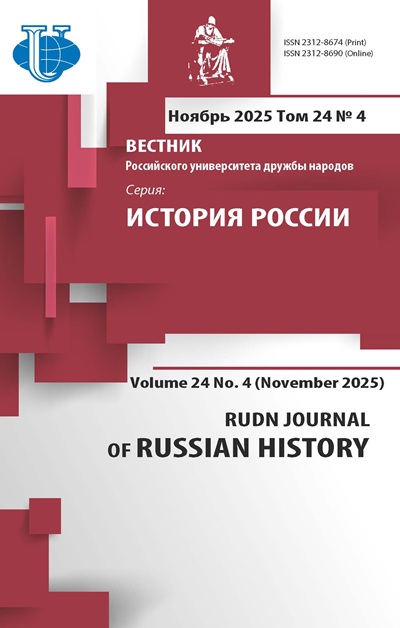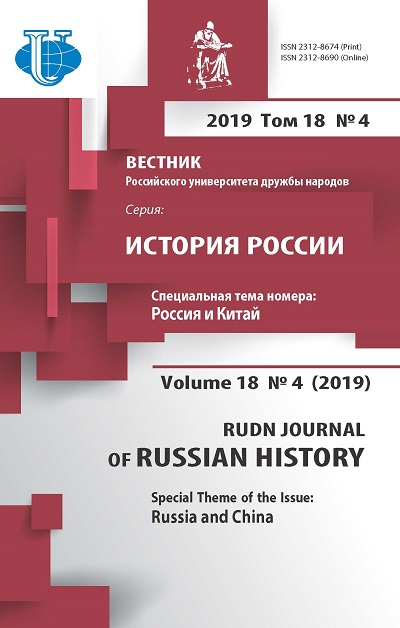The activities of Russian public organizations in China in 1917 (on the example of the Russian colony in Manchuria and Xinjiang)
- Authors: Nazemtseva E.N.1
-
Affiliations:
- Military Academy of General Staff of the Russian Armed Forces
- Issue: Vol 18, No 4 (2019): RUSSIA AND CHINA
- Pages: 758-778
- Section: RUSSIA AND CHINA
- URL: https://journals.rudn.ru/russian-history/article/view/22306
- DOI: https://doi.org/10.22363/2312-8674-2019-18-4-758-778
- ID: 22306
Cite item
Full text / tables, figures
Abstract
The article analyzes activities of Russian public organizations in China in 1917 after the Russian February Revolution of 1917. Previously unstudied archival sources demonstrate that during that period, a large Russian diaspora formed in the Republic of China. Its composition depended on the specifics of the region. Information about the events in Russia and the revolutionary agitators arriving in China sharply intensified political life in the Russian colonies. This tendency was most pronounced in Manchuria, where the Chinese Eastern Railway (CER) had a key influence on the life of the Russian diaspora. Beginning in March 1917, various public organizations and associations began to form here - executive committees, councils of workers’ and soldiers’ deputies, party cells of the RSDLP(b). Throughout the year, rallies, demonstrations, and meetings were held in Harbin in support of the revolution and against the Russian administration of the road; here the sentiment was caution and distrust towards the events in Russia. The destabilization of the political situation caused dissatisfaction of the Chinese authorities and the international community, as it violated the work of the CER and led to the introduction of Chinese troops in Harbin. While in Xinjiang public organizations were less active in 1917 they nevertheless aroused the Chinese leadership’s concern, as agitation could easily lead to serious ethnic conflicts, especially multinational East Turkestan had not yet recovered from the 1916 uprising. There were no such organizations in Shanghai, Beijing and Tianjin. However, one of the main consequences of these events was the weakening of Russian positions in China, as well as in the Far East and Central Asia as a whole.
About the authors
Elena N. Nazemtseva
Military Academy of General Staff of the Russian Armed Forces
Author for correspondence.
Email: elenanazz@mail.ru
Doktor istoricheskikh nauk [Dr. habil. hist.], senior researcher at the Research Institute (Military History), Military Academy of General Staff of the Russian Armed Forces.
14, Universitetskiy Av., Moscow, 119330, RussiaReferences
- Ablazhey, N.N. S vostoka na vostok: Rossiyskaya emigratsiya v Kitaye. Novosibirsk: SO RAN Publ., 2007 (in Russian).
- Ablova, N.Ye. Istoriya KVZHD i rossiyskoy emigratsii v Kitaye (pervaya polovina ХХ v.). Minsk: BGU Publ., 1999 (in Russian).
- Aurilene, Ye.Ye. Rossiyskaya diaspora v Kitaye. 1920–1950-ye gg. Khabarovsk: Chastnaya kollektsiya Publ., 2008 (in Russian).
- Goverdovskaya, L.F. Obshchestvenno-politicheskaya i kul’turnaya deyatel’nost’ russkoy emigratsii v Kitaye v 1917–1931 gg. Moscow: MADI Publ., 2000 (in Russian).
- Khodyakov, M.V. “ ‘Yellow Russia’ of the late XIX – early XX Centuries in the Geopolitical Plans of the Russian Military Elite.” Modern History of Russia 8, no. 4 (2018): 880–897 (in Russian).
- Krotova, M.V. SSSR i rossiyskaya emigratsiya v Man’chzhurii (1920–1930-ye gg.). St. Petersburg: Asterion Publ., 2014 (in Russian).
- Li Yingnan. “The Centenary of the October revolution in Chinese political, social and scientific thought.” Russian History, no. 6 (2018): 43–56 (in Russian).
- Nazemtseva, Ye.N. “How Russian public organizations defended the rights of Russian emigrants to China, 1917 to the early 1920s.” Russian History, no. 4 (2015): 51–62 (in Russian).
- Oleynikov, I.V. Antikrizisnaya deyatel’nost’ administratsii KVZHD v revolyutsionnoye vremya (1917–1920 gg.). Novosibirsk: NGPU Publ., 2012 (in Russian).
- Stavrov, I.V. “Nekotoryye voprosy adaptatsii rossiyan v Man’chzhurii v pervoy polovine ХХ v.” Oykumena, no. 4 (2010): 58–64 (in Russian).
- Van, Ch. Istoriya Russkoy kolonii v Shankhaye. Moscow: Russkiy put’ Publ., 2008 (in Russian).
- Yanchenko, D.G., and Starovoytova, Ye.O. “Prospects for the economic development of the Chinese Eastern Railway after the Russo-Japanese War: the regional dimension and the St. Petersburg policy.” Modern History of Russia 8, no. 3 (2018): 583–597 (in Russian).
Supplementary files















